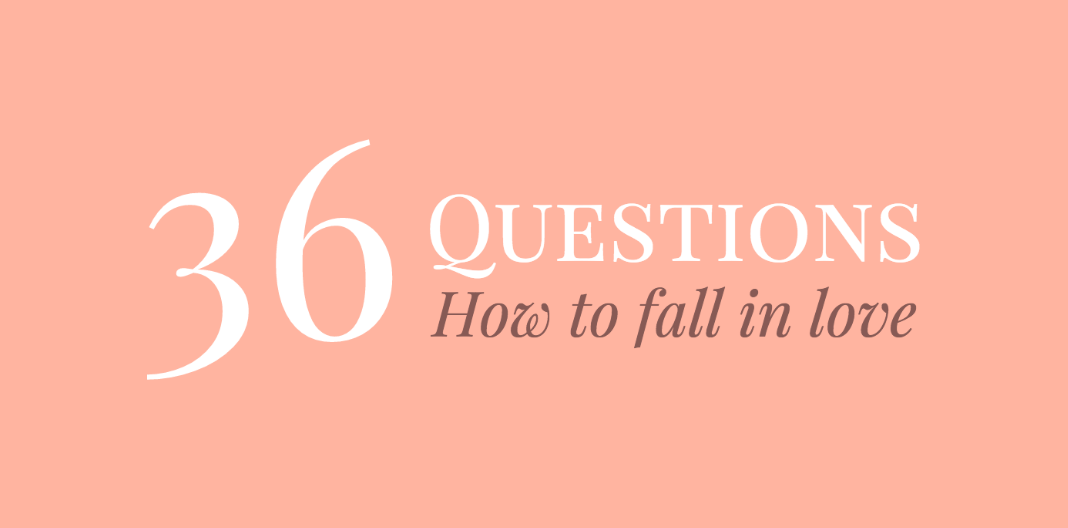The “36 Questions to Fall in Love” have garnered a lot of attention in recent years. The concept originates from a study by psychologist Arthur Aron, which shows how targeted questions can help build a deeper emotional connection between two people. Want to learn more about how questions work, where they come from, and how they can be used effectively to deepen relationships? In this article, you’ll learn more about the scientific background, get the complete list of questions, and learn how they can help you get to know each other on a deeper level.
The science behind the 36 questions
How do the 36 questions work?
The “36 Questions to Fall in Love” are based on a study by US psychologist Arthur Aron, first published in 1997 under the title ” The Experimental Generation of Interpersonal Closeness .” In this experiment, Aron brought couples who had previously not known each other closer together by asking them these specific questions. The goal was to initiate intimate and meaningful conversations that normally only occur between people in an established relationship.
Aron’s hypothesis is based on the idea that intimacy and emotional closeness can be fostered through the exchange of personal information and mutual understanding. The questions are therefore divided into three levels, each delving deeper into personal and emotional topics. This gradual progression is intended to encourage participants to show more vulnerability and thus build a deeper connection with their counterpart.
This method of promoting intimacy is supported by other studies. Cohen and Strayer (1996), for example, showed in their study that empathy plays a central role in establishing emotional closeness. The more respondents were able to put themselves in their counterpart’s shoes, the stronger the perceived connection.
Another aspect highlighted in the study by Laurenceau et al. (1998) is the importance of self-disclosure and the response of the interlocutor. Through the conscious disclosure of personal thoughts and feelings and the empathetic response to them, the intimacy between interlocutors can be sustainably deepened.
The “36 Questions” are therefore more than just a game – they are a scientifically based tool that can be used specifically to deepen interpersonal relationships and create a deeper emotional understanding.
The 36 questions
The questions: Step by step to falling in love
The 36 questions are divided into three levels, each increasing in intensity. Each level aims to deepen trust and familiarity between the interviewers. Below is the complete list of questions, which you can use in this order for the best results.
Step 1: Break the ice
- If you could invite anyone in the world to dinner, who would it be?
- Would you like to be famous? In what way?
- Have you ever rehearsed what you want to say before calling someone? Why?
- What does a “perfect” day look like for you?
- When was the last time you sang for yourself? And for someone else?
- If you could live to be 90 and have the body or mind of a 30-year-old for the last 60 years of your life, which would you choose?
- Do you have a secret premonition of how you will die?
- Name three things you have in common with your conversation partner.
- What are you most grateful for in your life?
- If you could change one thing about your upbringing, what would it be?
- Take four minutes and tell your conversation partner your life story in as much detail as possible.
- If you could wake up tomorrow with one new trait or skill, what would it be?
Level 2: Deeper questions
- If you could read the truth about yourself, your life, your future, or anything else in a crystal ball, what would you like to know?
- Is there something you’ve always wanted to do but never have? Why not?
- What was the greatest success in your life?
- What do you value most in a friendship?
- What is your best memory?
- What is your worst memory?
- If you knew you were going to die suddenly in a year, would you change anything about your lifestyle? Why?
- What does friendship mean to you?
- What role do love and affection play in your life?
- Take turns to name something you consider a positive character trait in your partner. Name five things in total.
- How close and welcoming is your family? Do you think your childhood was happier than most?
- What is your relationship with your mother?
Stage 3: Building trust and closeness
- Make three true “we” statements. For example: “The two of us in this room feel…”
- Complete this sentence: “I wish I had someone to share with…”
- If you were to become close friends, what would you want your partner to know about you?
- Be honest and say things you wouldn’t normally say to someone you just met.
- Tell your partner about an embarrassing moment in your life.
- When was the last time you cried in front of someone? And when was it in front of yourself?
- Tell your partner what you already like about him.
- What, if anything, is too serious to joke about?
- If you were to die tonight without being able to talk to anyone about it, what would you most regret not telling anyone? Why haven’t you told anyone yet?
- Your house, containing everything you own, goes up in flames. After saving your loved ones and pets, you still have time to save one last thing. What would that be? Why?
- The death of which family member would shock you the most? Why?
- Talk about a personal problem and ask your partner for advice on how they would handle it. Also, ask your partner to consider how you feel when you talk about this problem.
These questions require courage and openness, as they often delve deeper into the personalities of those involved than ordinary conversations. If you ask these questions in a calm and respectful setting, you can connect on a very deep and emotional level.
Here you will notice much faster than usual whether you harmonize with each other on a deeper level.
How the questions can help you
When and how to use the 36 questions
The 36 questions can be used in a variety of situations to deepen existing relationships or create a new connection. However, it’s important to choose the right time and context for applying these questions.
The first meetings:
These 36 questions can be an excellent tool for moving from the typical superficiality of initial encounters to a truly meaningful exchange. Gradually intensifying the questions allows the conversation to deepen naturally and create an atmosphere of trust. However, it’s advisable not to start with the most intense questions on the first date. Take it slow and make sure you both feel comfortable. We recommend asking these questions on the second or third date. By doing this, you’ll already know whether you generally like each other and can playfully deepen your acquaintance. Of course, this isn’t a requirement.
In-depth conversations in an existing relationship:
Even in long-term relationships, the 36 questions can be used to discover new facets of your partner and strengthen the emotional bond. Couples often fall into a routine where in-depth conversations about personal dreams, fears, or hopes are neglected. These questions offer a structured way to rekindle such conversations.
Use in couples therapy:
Couples therapists occasionally use the 36 questions as a tool to help couples reconnect and overcome old conflicts. The questions can help them gain new perspectives on their partner and develop a deeper understanding of each other.
A study by Sedikides and Campbell (1999) highlights that striving for self-improvement and self-disclosure can positively influence the quality of relationships. In this context, the 36 questions can act as a catalyst to initiate this process. Consciously examining one’s own answers and those of one’s partner can help one better understand oneself and the other, and can also take mature relationships to a new level.
Important information for conducting the conversation:
A respectful and open atmosphere is essential when using the 36 questions. Both partners should be willing to be honest and vulnerable, while also being sensitive to the other’s answers. It’s important to take your time and make sure both partners feel comfortable. If one partner feels a question is too personal, this should be respected.
Potential advantages and limitations of the method:
Although the 36 questions can be an effective tool for deepening relationships, it’s important not to view the method as a panacea. Not everyone will be able to open up in this way, and not every relationship will automatically be intensified by these questions. Sometimes, it may be necessary to take other supportive measures to strengthen or save a relationship.
Success and reviews
Do the 36 questions really work?
The “36 Questions to Fall in Love” have garnered worldwide attention and have been tried by many people to deepen their relationships. Numerous success stories demonstrate that this method can indeed work. Many couples report that answering the questions has helped them become closer and discover sides of their partner they hadn’t previously known.
For example, one LemonSwan couple who tried these questions on their first dates reported that after the conversation, they felt connected in a way they never expected. This intense and honest communication laid the foundation for a deep relationship that continues to this day.
Of course, there are also critical voices here. Some find the questions too intrusive or artificial and argue that true love and closeness cannot be created through a predetermined list of questions. This criticism is justified, because not every relationship or every person is the same. While some can build a deeper connection through the questions, others feel uncomfortable revealing so much about themselves. For this reason, we generally recommend waiting until the second or third meeting to ask more in-depth questions and not losing sight of the playful aspect.
Science also shows that these questions are not a panacea. A study by Sprecher et al. (2013) examined the relationship between self-disclosure and perceived closeness. The results show that self-disclosure can indeed have a positive effect on perceived closeness, confirming the effectiveness of the 36 questions. However, the success of this method depends heavily on individual personalities and the couple dynamics.
Another perspective is offered by the study by Slatcher and Pennebaker (2006), which examines the positive effects of expressive writing on interpersonal relationships. Here, too, it is shown that the conscious and structured exchange of thoughts and feelings—similar to the 36 questions—can strengthen interpersonal bonds.
Compared to other methods for deepening a relationship, such as couples therapy or shared experiences, the 36 Questions offer a simple and accessible way to get to know each other in a new way. They require no professional guidance and can be done anywhere, making them a flexible tool for couples.
However, it’s important to be aware that the 36 questions are no guarantee of falling in love or a successful relationship. However, they can be a wonderful way to lay the foundation for a deeper relationship and bring conversations to an honest and meaningful level.
Conclusion
The “36 Questions to Fall in Love” are more than just a viral phenomenon—they’re based on sound psychological research and offer a unique way to foster depth and intimacy in a relationship. While they’re no guarantee of love and commitment, they can be a powerful tool for initiating meaningful conversations and connecting with another person on a deeper level.
Scientific evidence and the experiences of many couples show that honest self-disclosure and empathetic responses are key elements for building a strong emotional bond. Whether on a first date, in a long-term relationship, or as part of a therapeutic intervention, the 36 questions offer a structured way to foster these elements.
Ultimately, it’s important that you approach this method with openness and respect. If you choose to apply the 36 questions in your own life, you should be willing to be vulnerable while also creating a space where your counterpart feels comfortable.
If you’re ready to dive deeper into your relationships, this could be the first step—or at least an interesting attempt to discover the magic of love through honest conversations.
If you would like to learn more about the psychology of love, we recommend the in-depth articles and interviews in our guide, which explore the deeper mechanisms of interpersonal bonds.
At LemonSwan, you have the opportunity to use these questions directly on our platform to connect with potential partners and reach a deeper level of acquaintance. Try it out and experience how these questions can enrich your encounters.





